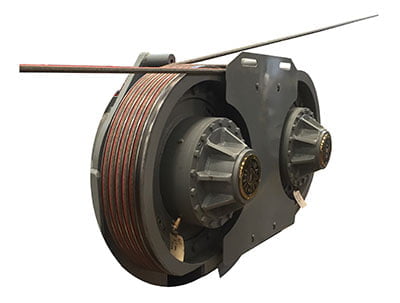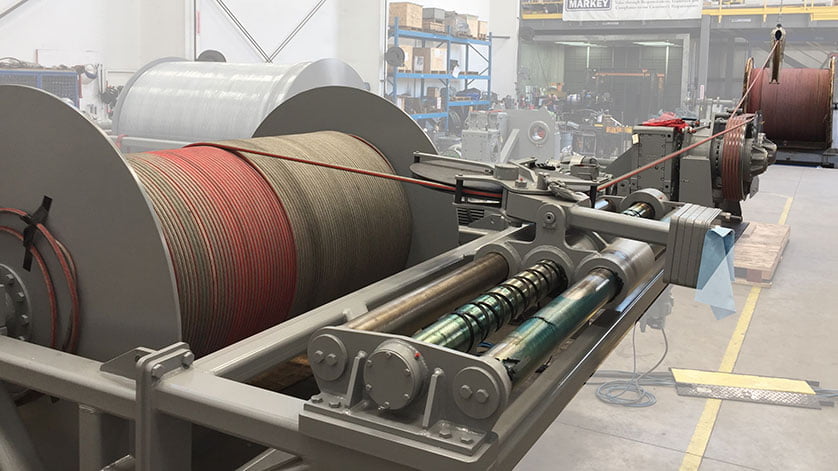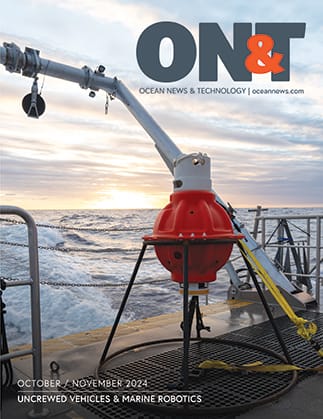Then in 2014 China’s Shallow Sea Technology Company approached Markey about an opportunity to represent the company’s research winch machinery in the bid process for the Ocean University of China’s planned Research and Training Vessel DONG FANG HONG #3. A key requirement of that opportunity would be providing traction winches capable of working with synthetic fiber lines at significant line loads and speeds.
Globally, there is increasing interest in the potential use of synthetic fiber cables in oceanographic systems. Ropes constructed of synthetic fiber exhibit the breaking strength of steel wire, yet are buoyant in water. Steel wire rope sinks due to the weight of the wire. Operations deploying steel wire at sea accumulate wire weight as more wire is deployed. This parasitic load deducts from the winch’s pull capabilities, whereas synthetic rope only minimally has an impact. This makes synthetic ropes superior for handling sizable loads while exploring ocean basins.
 Cantilevered Traction Wheels facilitate additional sixth groove. Credit John Davis – Markey
Cantilevered Traction Wheels facilitate additional sixth groove. Credit John Davis – Markey
Still, there are drawbacks to working synthetic lines. Markey engineers know this given the company’s long history of providing tug-mounted, high-response hawser winches utilizing synthetic line for ship assist and escort operation in high seas. For those unfamiliar with tug applications, one example of this technology is Markey’s Render-Recover® automatic line control. It is an automatic motion compensation technology developed to eliminate shock loading of synthetic hawser lines, a leading cause of early failure of synthetic ropes. Integrating this proven technology into traction winch systems utilizing synthetic rope ensures long rope life, and also improves depth position stability of deployed science packages.
Another advancement is in the area of line spooling. It addresses the slipperiness of synthetic rope, and the tendency of 12 strand braided ropes to knife into lower layers at line pulls of 20 ton and more. Markey engineers resolved this issue by increasing level wind speed so that successive layers cross over the preceding one at a relatively acute angle. This Markey innovation prevents upper layers pulling down between lower layers when under tension, which is unsuitable in any winch application.
Following receipt of the order for the five-winch package for the DONG FANG HONG #3 the Director of Shallow Seas Technology, Jimmy Wang, introduced Markey project engineers to a new type of line designed to be a direct replacement for steel trawl wires used in fishing applications. It helped to resolve some traditional technical issues encompassed in systems of this type. One involves the issue of traditional helical ropes and cables responding to increasing line tension by spinning. The new synthetic line, having both the rope and a durable cover made of braided synthetic fiber, is also torque-balanced due to the braided construction, making it ideally suited for bottom sampling at depth.
The traction winch performance requirements are substantially greater compared to research traction winches Markey has supplied in the domestic US market. Chinese operators required machines with load / speed parameters demanding 200% more power. To take full advantage of the traction head dual 150 HP electric motors (delivering 225kW total) the Ocean University of China required 22mm synthetic rope with 400kN minimum breaking strength. To meet the regulatory strength standards for pulling long cores imbedded in the sea bottom, Markey’s engineering team of Peter Petrov and Ross Murray designed a dual storage drum and single storage drum traction winch system with a number of new features. Among them are the addition of a sixth groove to the traction winch drums which ensures all 225 kW of motor power is transferred to the 12,000-meter rope to extract core samples and retrieve these to the research ship.
The combination of this new synthetic line with Markey’s latest high-performance traction winch design has resulted in a very powerful, high-performance machine. Some of the performance points include:
- Oceanographic deck machinery designed to handle cables with breaking strengths to 44,000 kg (96,800 lbf);
- Traction winch control systems using hawser winch-derived Markey Render/Recover® active tension compensation to protect synthetic line;
- Markey traction winches with 20,000 kg rated line pulls and light line speeds up to 120 meters per minute; and
- Traction winch machines designed specifically to work and effectively spool the newest high performance UHMP ropes.
Even during pre-shipment tension spooling of synthetic rope onto the new storage winch this system exceeded the expectations of Markey’s engineers. Under controlled factory conditions with the air gap characteristic of ‘round’ cable, the wraps accumulate and layers build as if spooling a double- armored cable. Coupled with the storage winch controls that include adjustable back tension while level winding the drums, confidence is high regarding level wind operation during actual operating conditions when the DONG FANG HONG 3 is at sea in 2019. Importantly, the observed results of tension spooling reinforces the value of applying Markey’s precision spooling principles of engineering level winds to select, synthetic ropes whose manufacturer’s guidance stipulates avoiding grooved drums.

